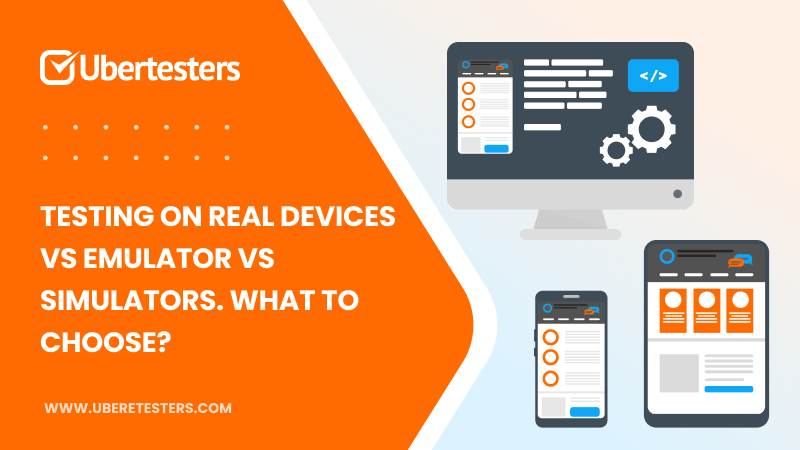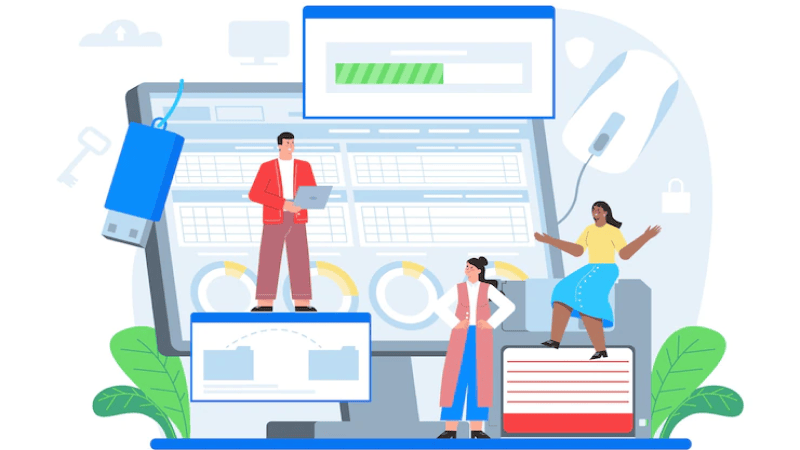Testing On Real Devices vs Emulator vs Simulator. What to choose?

Testing your application at different stages of the software development process is a must for launching a successful product. There are three most common options for cross-platform testing to choose from - emulators, simulators, and real devices. Which one is the most effective solution for polishing product quality? What are the real advantages and drawbacks of each method? It’s time to dive deeper into these popular alternatives.
Types of Testing Device Solutions

The device testing solution can be divided into two types. One type is testing using real devices and the other is testing using virtual devices (emulators or simulators). So, what testing approach will ensure the most accurate and reliable performance of your digital product? To get the answer to this question, it is crucial to understand the main concepts and key parameters of real device, simulator, and emulator in mobile testing.
Real Device Testing: The Basics
The most effective way of real-time performance testing is real device testing. This solution is used by big companies, middle-sized businesses, and startups because of its reliability, affordability, and top-notch results. It is about checking any digital product in any geography and in real-life environments - smartphones, tablets, smartwatches, laptops, and other devices with different models, operating systems, and hardware parameters. It allows testing a website or application on any device within various locations, under stress, and other variable parameters.
What are Emulators?
Using smartphone emulators is another common solution to complement a quality assurance process. The core principle of emulation is to enable a computer system to mimic different features of another device. In this case, the computer will be the host, while the target device is a guest. One can use emulators when one needs to check the outer behavior of the app. To put it simply, a phone emulator can be used when you need a substitute for a real original smartphone. It allows copying both hardware and software elements, creating the illusion of an actual device running the app. For example, what is an emulator for android? It is a software that replicates devices based on OS Android on your computer and allows you to test your app on different smartphones and tablets with no need to obtain each physical device.
What are Simulators?
Simulator testing is a way to model a special environment to mimic the configuration of a target device. It is used when there is a need to check the internal behavior of an app (e.g the dependency on firmware or hardware) but it does not mimic hardware. It can check features that are related to software only. In other words, using device simulators is focused on creating a space that copies the real-world device. As a result, you can explore how a particular device will likely perform in a real-life environment. However, it can’t precisely follow the operational principles of the real environment.
Simulators and Emulators: The Benefits

- Variety. The number of software for real mobile simulation is overwhelming. You can choose any option according to your needs and budget.
- Price. Most digital solutions of this type are available at a reasonable cost. Therefore, it will not likely leave your project’s budget empty.
- Starting on a baseline. Most emulating and simulating software are easy to use.
Cons of Simulators and Emulators
- Virtual devices are accessible only for a specific platform. Therefore, it sets up strict limitations for any QA process.
- Virtual device testing cannot replicate hardware configurations. There is no emulator or simulator that can cover the settings and additional hardware features you might need.
- Virtual testing can’t perform user base testing. Emulators/simulators can’t provide you with a clear and accurate representation of real-world scenarios.
- Performance validation is unreliable since these observations may vary with the OS enhancement. Consequently, you might fail to receive precise testing results.
- Emulators and simulators are really slow. Emulating or simulating the actual hardware usually makes the software run slower than it would natively.
Pros of Using a Real Mobile Device Testing on physical devices means that you test in the same way as your end-user who uses the same devices. Currently, it remains the most effective and reliable testing approach compared to other methods. Here is a list of benefits of testing your digital product on various real devices.
- There’s nothing like the real thing. Emulators and simulators can’t boast of having functionality that fully covers the features and functions of real smartphones, tablets, laptops, and other devices.
- Better user interface (UI) validations. The real mobile device testing approach is the only solution that allows making UI check-ups at an advanced level.
- More accurate performance testing. Since the tests are made on real devices, performance testing provides top-notch results that can’t be achieved when using emulators/simulators.
- Improved hardware & sensor-related validations that can’t be fully performed on virtual devices.
- Much faster to start testing with real devices. When it comes to using virtual devices, you might need lots of time for choosing and purchasing the most reliable and innovative software. Testing on real devices can be initiated in a faster and easier way.
Cons of a Real Mobile Device
- Cost - to get good results you must use a significant number of devices and buying devices at scale can be extremely costly.
- Slow debugging. If you want to get advanced testing results, get ready to wait.
- Device fragmentation. It is difficult to check an app’s performance on most mobile devices since their features, requirements, and functionality are often too different.
When Is It Better to Test on Emulator, Simulator, and Real Devices?

Choosing the optimal testing strategy often turns out to be complicated for many companies. First of all, it is important to analyze the type of your digital product, its requirements, and the target audience, as well as other specifications. This will help you select a unique testing environment for your individual needs. It is possible to use emulators and simulators at the early stages of the software development process. However, every digital product should be checked only on real devices before it reaches the hands of its customers. Moreover, when maintaining your app, implementing new features and functionality, making minor updates, it is crucial to pay attention to real device testing.
How to Overcome the Disadvantages of Real Device Testing
Crowd testing represents the most innovative approach to the quality assurance process. It combines technology with brilliant human skills, eliminating numerous testing issues. Also, crowd testing allows you to overcome all the drawbacks of using real devices - it’s a lower cost solution that allows a seamless debugging process, and getting access to any desired device to fight the fragmentation challenge. Crowd testing is a solution that allows testing your digital product on real devices by experienced QA professionals in real-life conditions. The entire quality assurance process is performed on real devices, carriers, and operating systems, depending on the client’s needs and product requirements. Being critically important before the release, crowd testing is a unique solution that can be used at all stages of the development process. Using the service, you will not need to purchase any additional devices for your QA needs or send your testing team to other countries to perform real-life testing. A crowd testing company will do the entire testing job for you, helping you to get excellent testing results while saving costs.
Conclusion
All in all, emulators and simulators might be a good solution to cover the basic testing needs, and mainly the software part. If you want to come up with a modern, feature-rich, adaptive, and user-friendly digital product, it is important to run tests on real devices. Most companies can’t cover a whopping number of different devices for advanced testing in real environments. The good news is that it is now easy to start cooperation with a third-party testing company. A reliable partner can use the power of expert QA professionals that have different physical devices in different parts of the world. With Ubertesters, a professional, well-known, crowd testing company, you can get all the advantages of testing your product on real devices. It is an affordable, cost-effective solution that will help you check all the app’s features and functionality in the most innovative way. You can manage the types of devices, and the number of testers, get detailed testing reports and even get help from an experienced project manager to make sure your digital product will be warmly welcomed by your target audience. Want to know even more advantages? Contact us at sales@ubertesters.com for more details.

